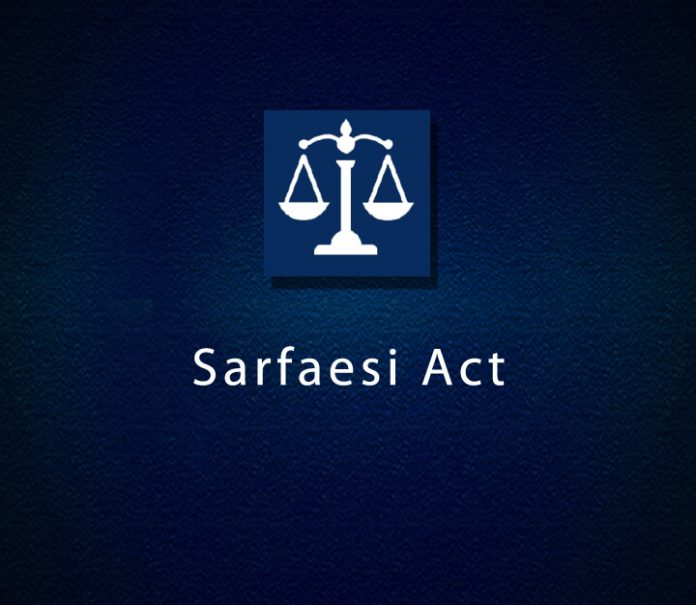

This article is written by Jaya Vats, a practising advocate, Delhi. In this article, the author provides a detailed study on all the aspects related to the SARFAESI Act, of 2002. The article provides an in-depth analysis of the purpose, need, and lacunae of the SARFAESI Act along with its relevance.
Table of Contents
The financial sector has been a crucial player in India’s efforts to succeed in swiftly building the nation’s economy. As our current legal framework for business transactions has not kept up with evolving commercial practices and banking sector changes. This assures a poor rate of loan recovery and rising volumes of nonperforming assets at banks and other financial institutions.

The Central Government established the Narasimham Committees I and II, as well as the Andhyarujina Committee, to investigate banking sector reforms. These committees assessed the necessity for changes in the legal framework in these sectors. These committees proposed new laws for Securitisation and permitting financial institutions to hold securities and sell them in a timely manner without the involvement of a court, and the recommendations formed the SARFAESI Act, 2002.
Under the Securitisation and Reconstruction of Financial Assets and Enforcement of Security Interest (SARFAESI) Act, 2002, banks in India have been granted the ability to acquire the security supplied by the defaulting borrower against the loan and sell it to recover losses, without the intervention of any court of law, providing them with a method to dramatically decrease their non-performing assets (NPA’s). The statute is abbreviated as the SARFAESI Act or simply SARFAESI. In the event of the borrower’s default, the law allows banks to seize and auction off the security against the loan.
The SARFAESI Act is defined as “an act to govern Securitisation and reconstruction of financial assets, as well as the enforcement of security interests, and to provide for a centralised database of security interests formed on property rights, and for issues associated with or incidental thereto.”
The SARFAESI Act was enacted with the intention of allowing banks and other financial institutions (FIs) to recuperate on NPAs without the intervention of a court. The non performing assets are defined under Section 2(1) of the Act. These are the financial institutions that have a presence in India and have been notified by the Indian government. The Act specifies two broad strategies for recovering NPAs. This involves either taking ownership of the borrower’s secured assets (with the power to lease, assign, or resell the secured assets) or taking over the borrower’s management or company until the NPA is retrieved. The Act also allows banks and other financial institutions to sell financial assets to Asset Reconstruction Companies (ARCs). The financial assets can be sold to ARCs in compliance with the Reserve Bank of India’s (RBI) norms and recommendations.
The secured creditor’s right to pursue the security interest under the Act does not arise until the borrower’s account has been categorised as an NPA in the secured creditor’s (banks or financial institutions’) books of account in accordance with the RBI standards. The secured creditor must serve the borrower with a 60-day notice seeking repayment of the amount owed and describing the borrower’s assets on which the secured creditor intends to exercise its security interest.
If the borrower fails to fulfil its liability to the secured creditors after the 60-day notice period has expired, the secured creditor may enforce security interest over secured assets by:
If a secured creditor is unable to recover the whole sum owed through the enforcement of a security interest over the assets secured, the secured creditor may seek recovery of the balance amounts through the Debts Recovery Tribunal (DRT) or the applicable court. A secured creditor may seek its remedies under both the SARFAESI Act and the DRT at the same time. For the SARFAESI Act to apply, the borrower’s account must be classed as an NPA by the secured creditor and have an outstanding balance of INR 100,000 or more. Furthermore, the requirements of the Act are not enforceable in certain cases, as outlined in Section 31 of the SARFAESI Act, such as an account where the residual debt is less than 20% of the initial principal amount and interest.
The SARFAESI Act is applied to the entire country of India. The SARFAESI Act, 2002 provisions are in effect for modifying the four laws listed below:
The SARFAESI Act has two main objectives, namely:

The characteristic of Indian industry is economic indiscipline or financial illiteracy. The ever-increasing Non-Performing Assets (‘NPA’), a fine euphemism devised to describe poor loans, led to the passage of the Recoveries of Debts due to Banks and Financial Institutions Act, 1993, which established a special Debt Recovery Tribunal (‘DRT’), defined under Section 2(1)(i) of the Act to reclaim NPA. However, on one hand, this did not speed up the recovery, and on the other hand, the severe civil law requirements rendered the attachment and foreclosure of the assets offered as security for the loan nearly worthless. Furthermore, the balance sheets of banks and other financial institutions were turning red as a result of large mandated provisions for non-performing assets (NPAs).
Recognising that one out of every five borrowers is a defaulter, the government was under obligation to provide proper mechanisms for debt recovery as well as to foreclose the security. Hence, The SARFAESI Act, 2002 (the Securitisation Act) attempts to fulfil these dual goals, as well as to provide a wide legal framework for asset Securitisation and asset reconstruction.
The Act addresses the following issues:
The SARFAESI Act does not apply to:

The efforts of the financial industry have been a crucial role in the rapid advancement of India’s economy. Despite the fact that Indian banks and financial institutions were keeping up with international standards and rules, there were gaps in several areas. Concerns included a lack of power with financial firms to reclaim defaulted loans.
Therefore, the SARFAESI Act, 2002 was passed after careful consideration, allowing banks and financial institutions to solve issues like liquidity, long-term assets, growing NPAs, and loan recovery delays (reconstruction).
The following are the key aspects of the SARFAESI Act:
The SARFAESI Act intends to securitize and rebuild financial assets via two special purpose entities, namely the ‘Securitisation Company (‘SCO’)’ and the ‘Reconstruction Company (RCO’). SCO and RCO must be companies formed under the Companies Act of 1956 with the primary purpose of securitisation and asset reconstruction, respectively. Before conducting business, SCO and RCO must be registered under the SARFAESI Act. Furthermore, a minimum financial stability criterion is established by mandating SCO and RCO to have an owned fund of Rs. 2 crores or up to 15% of total financial assets acquired or to be acquired. The RBI has the authority to set the rate of owned funds at any moment. For different types of SCO and RCO, various rates might be set. Existing SCO and RCO are likewise obliged by the SARFAESI Act to register. The RBI must be contacted in order to process the registration application. The SCO or RCO that has acquired a certificate of registration under the SARFAESI Act is a Public Financial Institution as defined in Section 4A of the Companies Act of 1956.
Aside from its core activity of securitisation and asset reconstruction, a SCO/RCO may carry out the following tasks:
An SCO or RCO that is engaged in any other business other than securitisation or asset reconstruction prior to the beginning of the SARFAESI Act must cease such other activity within one year of the SARFAESI Act’s commencement.
Only banks and financial institutions are permitted under the SARFAESI Act to securitise their financial assets relevant to NPAs with a securitisation firm. According to the SARFAESI Act, securitisation is the acquisition of financial assets from any financial institution or bank by any securitisation company or reconstruction business. The necessary funds for such acquisition may be acquired from ‘qualified institutional buyers (QIB)’ by the issuance of security receipts reflecting an undivided interest in such financial assets, or through other means.
The following are financial assets:
The SARFAESI Act established a much-needed legal framework for the securitisation of financial assets. Securitisation of financial assets is a financial instrument that allows lenders to securitise their future cash flows from secured assets and therefore free up funds that have been held in such assets. The secured assets become “merchandise” in the hands of the SCO and RCO, and their realisation provides them with their return. This feature adds much-needed skill in effective management in the realisation of secured assets. By enabling the enforcement of the secured assets, the legal hurdles of conventional civil law procedure to seize the mortgaged assets have thus been successfully removed.
Securitisation of financial assets may take a while to bear fruit since it necessitates strong accounting principles, as well as the establishment of standards. In other words, in addition to the legal structure, there should be an accounting framework.
By issuing a security receipt, the SCO/RCO may raise the required money from the QIB for the acquisition of financial assets. The Registration Act exempts security receipts from mandatory registration. Securities receipts provided by any SCO or RCO are considered “securities” under Section 2(h)(ic) of the Securities Contracts (Regulation) Act, 1956. For each purchase, a scheme of acquisition must be developed, describing the description of financial assets to be acquired, the amount of investment, the rate of return guaranteed, and so on. In addition, separate and unique accounts must be kept for each plan of purchase. Realisations from financial assets must be kept and utilised for the redemption of investments and the payment of guaranteed returns.
In the case of non-realisation of financial assets, the QIB owning at least 75% of the total value of the security receipts issued has the authority to summon a meeting of all QIBs and make resolutions, which are binding on the SCO/RCO.
According to RBI standards, an SCO or RCO may carry out asset reconstruction in any of the accompanying directions:
However, the aforesaid actions are subject to the requirements of any other legislation that is now in effect.
The secondary purpose of the SARFAESI Act is to allow for the enforcement of security interests, which entails taking ownership of the assets pledged as collateral for the loan. Section 13 of the Act gives detailed provisions allowing a lender (referred to as a “secured creditor”) to seize the borrower’s security. The provisions are as follows in their entirety and substance:
A central registry is being established to govern and control the functions of securitisation, asset reconstruction, and the development of security interests. Branch offices of the central registry may be formed on an as-needed basis. The registry will be led by a central registrar. The central registry performs the following functions:
The general provisions of the SARFAESI Act are as follows:
By introducing two provisions in Section 15 of the SICA, the protective canopy of registering with BIFR under the Sick Industrial Companies (Special Provisions) Act, 1985 (‘SICA’), which had previously incentivized industrial illness, has been abolished. They are as follows:
The following transactions are excluded from the SARFAESI Act’s provisions:
Banks must follow particular procedures before they may repossess and claim a property in order to recoup their debts. They work in accordance with the SARFAESI Act procedure. Under the SARFAESI Act mechanism, if a borrower seems unable to settle his loan (including house loans) for six months, the financial institution has the legal authority to issue him a notice requesting that he clear the dues within 60 days. If the borrower fails to satisfy this obligation, the financial institution has the authority to sell the property in distress in order to collect the debt.
A borrower in default who is dissatisfied with the bank’s order may file an appeal with the appellate body established by law within 30 days of the date the order is issued.
Once the bank obtains possession of the property, it has the option to sell or lease it. It can also provide another entity the right to the property. The revenues from the sale are used to pay down the bank’s outstanding debts first. The leftover funds, if any, are paid to the defaulting borrower.
The RBI is responsible for the regulation and registration of securitisation or rebuilding businesses under the SARFAESI Act of 2002. These firms have been given permission to raise cash by selling security receipts to a qualified institutional buyer. This has enabled banks and financial institutions the authority to take control of securities issued in exchange for financial assistance and sell or lease them in order to take over management in the event of a failure. The SARFAESI Act specifies two basic techniques for recovering non-performing assets and these are as follows:
The SARFAESI Act also includes an exception for security receipt registration. It implies that when a securitisation or reconstruction firm issues receipts, the holder of the receipts is entitled to undivided interests in the financial assets and there is no requirement for registration until and until the Registration Act, 1908 requires it. However, in the following circumstances, the security receipt must be registered:
The SARFAESI Act defines the following offences under Chapter-V under Section 27-30D:
The SARFAESI Act under Section 27 imposes the following penalties:
Under the SARFAESI Act, only a Metropolitan Magistrate or a Judicial Magistrate of the First Class has the authority to take cognizance and trial a crime.
The administration has indicated that it wants to dramatically reduce the number of non-performing assets (NPAs) and remove the obstacles they provide to the economy. The SARFAESI Act is a method for achieving this aim by reducing NPAs. As a result, the efficacy or success of the Act must be measured by the results obtained throughout its implementation. If the Act has resulted in a downward cycle of NPAs, it will be considered a policy success. Most banks have significantly lower levels of non-performing assets, and many have budgeted for even lower NPA levels this fiscal year.
Cooperative banks were previously excluded from the category of banks to whom the SARFAESI Act applied. The Indian government revised this act in 2013 to include cooperative banks formally under the scope of banks qualified to employ this Act. This action has greatly aided cooperative banks in avoiding excessive delays in collecting problematic debts that are involved in civil courts and cooperative tribunals.
With significant deposits from ordinary investors, the Indian Banking System today contains 1,544 urban cooperative banks and 96,248 rural cooperative banks. Given their magnitude in order to timely recover the default debts the SARFAESI Act plays a vital role leading to the cooperative banks’ smooth operation.
The SARFAESI Act, regardless of how advantageous it is, is not without flaws. One of the Act’s significant flaws is that it does not apply to unsecured creditors.
The bank has no influence over what happens to the asset after it is placed up for auction. If there are no buyers for the asset at the auction, the bank cannot proceed, pursuant to the previous conditions. Furthermore, the Government of India added a new clause in 2011 declaring that the bank might acquire the asset if there was no better bidder. This created another issue that if the factory was in the city, the bank might buy it and use it to erect a new branch or build a housing colony for its employees. However, if it was in an extremely remote place, it was useless to the bank.
The Act’s provision permitted the bank to keep a specific asset for a maximum of seven years. However, if the bank does not get a reasonable bid within the specified time frame, the remedy for such a situation is not specified in the Act.
The legality of the Act was questioned in the case of Mardia Chemicals v. Union of India, 2004 before the Supreme Court.
Facts: The IDBI Bank filed a notice against Mardia. Mardia defaulted—appealed in Court, where a number of similar petitions were grouped together and addressed collectively.
Issue: The Court had to decide whether it was permissible to challenge the SARFAESI Act on the grounds that it was not necessary to enact it in the circumstances at the time, particularly when another statute was already in effect, whether Section 13 of the Act was unconstitutional, and whether Section 17, particularly Section 17(2), is unreasonable and arbitrary, and thus unconstitutional.
Held: The Supreme Court upheld the Act’s constitutional validity, noting that “certain provisions of the Act may be a bit harsh for some of the borrowers, but on the ground that the impugned provisions of the Act cannot be said to be unconstitutional for the very fact that the object of the Act is to achieve faster recovery of the dues declared as NPAs and for better availability of capital liquidity and resources to help in the growth of the country’s economy and borrowers.” The Court further permitted the debtors to file an appeal against the lending institutions at the DRT without having to deposit 75% of the outstanding debt, and if the tribunal does not grant a stay order, the bank may sell the possessions.
Facts: The appellant challenged Vishwasrao Patil Murgud Sahakari Bank Limited’s action under the SARFAESI Act before the Civil Judge in Spl. Civil Suit on August 13, 2008. In deciding the primary issue, the Trial Court determined that it lacked jurisdiction to hear the case. The first appeal filed was denied. Against that, an appeal has been filed with this Court. A supplementary writ challenge under Article 32 of the Indian Constitution has also been filed, disputing the scope of the SARFAESI Act by co-operative banks sending notifications under Section 13.
Issue: One point of contention was whether cooperative banks at the state and multi-state levels are subject to the SARFAESI Act.
Held: A Five-Judge Constitution Bench of the Supreme Court of India ruled that cooperative banks created by cooperative societies should be recognised as banks under the SARFAESI Act, 2002.
Facts: In relation to the loans taken out by the industrial enterprises, the respondent provided sureties and/or guarantees. It sought the appellant-Corporation for a loan of 100 lakhs in the shape of a non-convertible debenture facility to cover its working capital requirements. respondents who were directors of the company signed guarantee and collateral security deeds that eventually failed.
Issue: The legitimacy of SARFAESI Act,2002 was challenged.
Held: The Supreme Court correctly emphasised the importance of the fundamental right to property. As a result, both creditors and lenders are guided as to the requirement of the asset mortgaged to the bank. The Supreme Court of India maintained the SARFAESI Act, 2002 as constitutionally legitimate, with the exception of the provisions under Section 17(2) of the Act, 2002, which was found to be in violation of Article 14 of the Indian Constitution.
Facts: In 2005 the respondent approached the applicant banks for working capital and term loan facilities, including short-term loans, and entered into loan agreements with the applicant banks. However, due to financial problems, the respondent defaulted on repayment of such loans, and in response to bank requests for repayment of the loans, the respondent sought applicant banks, among other things, to restructure and recast the said credit facilities. However, the respondent is now a fugitive offender. Under the SARFAESI Act, the applicant-banks have begun proceedings against the defendants’ secured assets.
Issue: The main issue was as the respondent is a fugitive offender, can he remain outside the jurisdiction during the winding-up process.
Held: The Karnataka High Court held that a secured creditor may opt to remain outside the winding-up process while also preferring a company petition, and the Company Court may not exercise sovereignty over the property when recourse is sought against the secured asset by a secured creditor under the SARFAESI Act. When a secured creditor has sought recourse under the SARFAESI Act, the Company Court cannot exercise jurisdiction over the secured assets, whether before or after the winding-up order is issued, according to the Court. This is due to the fact that if a secured creditor files a petition for winding up, he is not required to renounce his secured asset.
Facts: the borrower was served with a notice under Section 13(2) of the SARFAESI Act, 2002, requesting a particular quantity of money. The bank took symbolic possession of the immovable property/residential residence and sent a notice in accordance with Section 13(4) of the SARFAESI Act, 2002. The bank published a notice of public auction for the sale of the residential property.
Issue: The appellant claimed that the DRT’s decision in favour of the bank violated Section 13(8) of the SARFAESI Act, 2002.
Held: The Supreme Court held that the borrower cannot be freed from the total responsibility due unless and until the borrower was ready to deposit/pay the complete amount payable, including all charges and expenditures, with the secured creditor. Furthermore, it held that a bank cannot be barred from disposing of the mortgaged property at public auction and realising the proceeds, and recovering the remaining debts until the borrower deposits/pays the total amount due and payable, as well as the fees paid by the secured creditor, in accordance with Section 13(f) of the SARFAESI Act.
Significant improvements in the SARFAESI Act, 2002 have occurred in recent years in order to meet the requirements of the statute. The judiciary has traditionally aided in keeping uncertainties about the application of legislative provisions at bay. As a result, the Supreme Court correctly affirmed the substantial development in the scope of the SARFAESI Act, 2002. The SARFAESI Act, 2002 is a vital Act for the advancement of the country’s economy, and broadening its scope is regarded as a necessary step in strengthening the country’s financial institutions.
Students of Lawsikho courses regularly produce writing assignments and work on practical exercises as a part of their coursework and develop themselves in real-life practical skills.
LawSikho has created a telegram group for exchanging legal knowledge, referrals, and various opportunities. You can click on this link and join:
Follow us on Instagram and subscribe to our YouTube channel for more amazing legal content.
